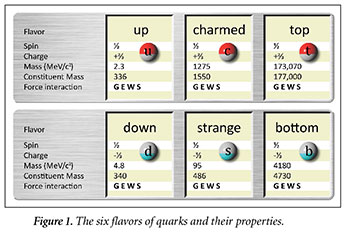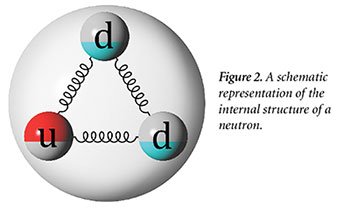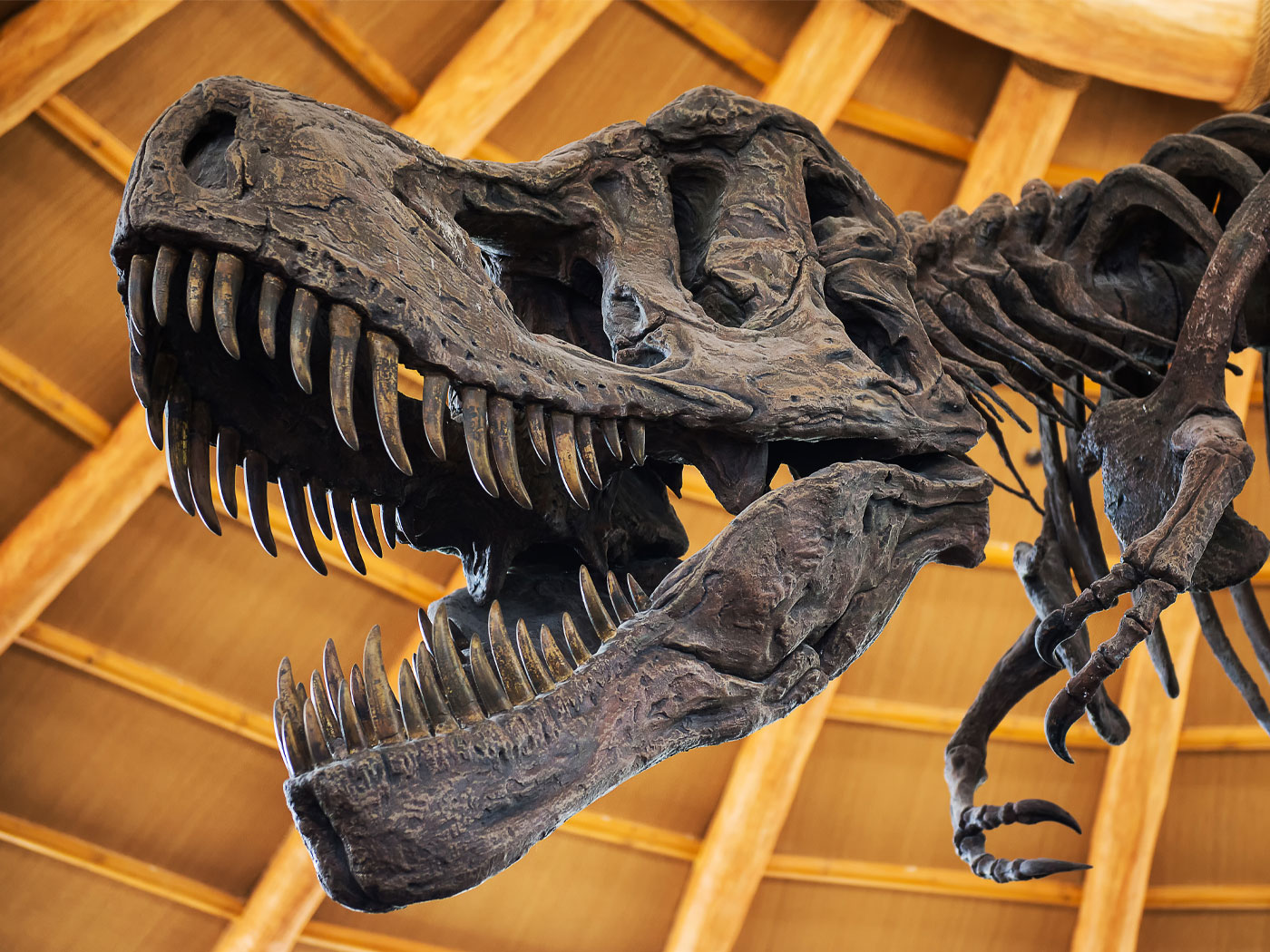by Jason Lisle, Ph.D., and Vernon R. Cupps, Ph.D.*
In the fifth century B.C., the Greek philosopher Democritus and his mentor Leucippus proposed that all matter is composed of tiny indivisible particles far too small to see. The Greek word meaning indivisible is atomos, from which we get the modern term atom. Democritus further supposed that the properties of all matter could be determined from the shape and properties of the component atoms. Such insight is remarkable considering the technological limitations of the time.
Today, we know that atoms do indeed comprise all visible matter and determine the properties of matter. But we now know that atoms are in fact divisible and are therefore not the smallest particle. Atoms are themselves made of protons, neutrons, and electrons. As we study these and other particles, we see that they fall into organized families and that they obey established laws of nature. Laws always imply a lawgiver. Therefore, a better understanding of the families of particles reveals the awesome intelligence of our Creator. Furthermore, the properties of matter continue to frustrate those who reject biblical authority.
Nucleons
In part 1 of this series,1 we discussed the properties of leptons, the family of “light” particles that includes the electron. Here we examine baryons, the family of particles that includes the protons and neutrons found in the nucleus of an atom. Baryons are composite particles, meaning they are made of even smaller particles called quarks. Protons and neutrons are classified as nucleons because they occur in the nucleus of atoms.
Protons and neutrons are each over 1,800 times heavier than electrons. Protons have a mass of 1.6726219 × 10-27 kilograms and an electrical charge of positive 1 (+1). Neutrons are slightly heavier than protons, with a mass of 1.67492747 × 10-27 kg, and have no net electrical charge. All atoms have at least one proton in the nucleus, and all stable atoms except hydrogen have at least one neutron as well. Consider the helium nucleus, for example. Helium has two protons and (generally) two neutrons comprising its nucleus. But the protons pose a paradox. Each of the two protons has an electric charge of +1 and like charges repel. So what keeps the protons from flying apart?
 The fact that protons stick together in the nucleus implies that there must be some attractive force between these particles that is stronger than the electromagnetic force—a nuclear force. We now know that there are in fact two types of nuclear force. The force holding protons together is the stronger of these two, so we call it the strong nuclear force, or simply the strong force.
The fact that protons stick together in the nucleus implies that there must be some attractive force between these particles that is stronger than the electromagnetic force—a nuclear force. We now know that there are in fact two types of nuclear force. The force holding protons together is the stronger of these two, so we call it the strong nuclear force, or simply the strong force.
Quarks
Perhaps the best way to understand the properties of protons, neutrons, and other baryons is in terms of their constituent particles—quarks. Figure 1 lists the six types of quarks and their properties. In some ways, quarks are similar to the leptons we covered in the previous article. Quarks are thought to be elementary (made of nothing smaller), like leptons. They have a spin of 1/2, which means they are classified as fermions, just as leptons are. And there are six types (called flavors) of quarks, just as there are six flavors of leptons. But there are differences.
Unlike leptons, quarks respond to the strong nuclear force. Also, by convention quarks have a fractional electrical charge—either positive 2/3 (+2/3) or negative 1/3 (-1/3), depending on the quark flavor. Quarks are the only known particles with fractional charge. There are also six antiquarks, with identical mass to each flavor of quark but with opposite electrical charge.
Physicists have assigned amusing names to the six flavors of quarks. In order of increasing mass, they are the up quark (represented by the letter u), the down quark (d), the strange quark (s), the charmed quark (c), the bottom quark (b), and the top quark (t). The quarks having a charge of +2/3 are the up, the charmed, and the top. The down, the strange, and the bottom have the -1/3 charge.
Quarks only exist in tight proximity to other quarks; they are never completely isolated. We will explore why this occurs in a later article. This affinity makes them difficult to study directly, but we can study the properties of the particles they comprise. Quarks bind to other quarks due to the strong nuclear force, the same force holding the protons and neutrons together in the nucleus. The up and down quarks are the least massive and are quasi-stable, depending on how they are arranged within the larger particle. The strange quark is slightly heavier and is unstable. The remaining three quarks are “heavy” and unstable; they rapidly decay into other particles.2
Hadrons and Baryons
 A hadron is defined as a particle that is composed of any combination of quarks or quarks and antiquarks. There are two subcategories of hadrons—mesons and baryons. A meson is made of one quark and one antiquark. We will cover these in the next article. Baryons are made of exactly three quarks.3,4 The proton and neutron are the lightest baryons, but many other kinds exist as well.
A hadron is defined as a particle that is composed of any combination of quarks or quarks and antiquarks. There are two subcategories of hadrons—mesons and baryons. A meson is made of one quark and one antiquark. We will cover these in the next article. Baryons are made of exactly three quarks.3,4 The proton and neutron are the lightest baryons, but many other kinds exist as well.
Protons (represented by the symbol p+) are composed of two up quarks and one down quark, written as uud. This accounts for the charge of a proton being +1. A neutron (n0) is composed of one up quark and two down quarks (udd), which results in its net charge of zero (see Figure 2). This also partially explains why the neutron is slightly heavier than the proton; the down quark is slightly more massive than the up quark, and the neutron has two downs whereas the proton has only one.5
Like electrons, quarks all have a spin of 1/2, which can either be in a spin up (+1/2) state or spin down (-1/2) state. And since they only occur in groups of three for all hadrons, the total size of the spin must always sum to a half-integer, either 3/2 or 1/2. Thus, all baryons are fermions, particles with half-integer spins. The proton and neutron each have a spin of size 1/2 since two of the quarks will take opposite spin states.6
The various combinations of quarks lead to a variety of different baryons. As one example, the lambda (Λ0) is a baryon composed of an up quark, a down quark, and a strange quark.7 By adding the charges of the quarks, we can see that the lambda is a neutral particle. It is much like a neutron but with one of the down quarks replaced by the heavier strange quark. As a result, the lambda is more massive than a neutron. Physicists classify baryons into six families based on the quark content and relative spin state of the quarks. Two examples from each family are listed in Figure 3.
One cannot compute the mass of a baryon simply by adding the masses of its constituent quarks. The energy binding the quarks also manifests as mass. Physicists do not yet understand the precise way in which quarks are organized within baryons, and this makes it impossible to predict from theory their exact mass. Instead, physicists measure the mass of baryons experimentally. However, as a general trend, those baryons composed of the heavier quarks tend to be more massive than those composed of lighter quarks—just as we might expect. For example, the charmed lambda is made of one up quark, one down quark, and one charmed quark; it is heavier than the lambda, which is heavier than the neutron.
 The type and mass of baryon depend not only on the composition of quark flavors but also on their arrangement. For example, consider the neutral delta particle (see Figure 3). It is a baryon made of two down quarks and one up quark. It has exactly the same quark composition as a neutron, yet it is more massive than a neutron. This is because all three quarks have the same spin alignment in the delta, producing a higher energy state that results in additional mass. The spin alignment of all three quarks gives rise to the neutral delta’s spin of 3/2 rather than the neutron’s spin of 1/2.
The type and mass of baryon depend not only on the composition of quark flavors but also on their arrangement. For example, consider the neutral delta particle (see Figure 3). It is a baryon made of two down quarks and one up quark. It has exactly the same quark composition as a neutron, yet it is more massive than a neutron. This is because all three quarks have the same spin alignment in the delta, producing a higher energy state that results in additional mass. The spin alignment of all three quarks gives rise to the neutral delta’s spin of 3/2 rather than the neutron’s spin of 1/2.
The Baryon Number Problem
In addition to charge and spin, baryons also have a quantum property called baryon number.8 All baryons have a baryon number of +1. All quarks have a baryon number of +1/3. Conversely, antibaryons and antiquarks have a baryon number of -1 and -1/3 respectively. This is important because baryon number is a conserved property just like energy, charge, spin, and lepton number. This constrains how baryons can decay and how they can form. The total baryon number before and after any particle interaction must remain unchanged.
This presents an enormous challenge to Big Bang supporters. The energy from extremely energetic particle collisions is sometimes sufficient to produce baryons. However, due to conservation of baryon number, any such collision must produce an equal number of antibaryons. According to the Big Bang model, all the baryons in our universe were produced from the energy of the Big Bang. If that were so, then the number of baryons in the universe should exactly equal the number of antibaryons. But it doesn’t. Antibaryons are extremely rare.
God had a good reason for creating the universe with an overabundance of baryons. When antibaryons come into contact with baryons, they destroy each other. So, it is necessary for our existence that antibaryons are rare. And it is no problem for God to create baryons only because He is not limited to natural means. The overabundance of baryons in the cosmos is powerful evidence against the Big Bang model but is amazingly consistent with biblical creation.
Baryon Decay
The proton is the lightest baryon, and it is stable. All other baryons are unstable in isolation and will spontaneously decay into other particles. It may come as a surprise that even neutrons are unstable in isolation. A neutron has a half-life of about 10.3 minutes.9 That may seem short, but it is remarkably long compared to most other particles, whose half-life is microseconds or less. Even so, eventually one of the neutron’s down quarks decays into the lighter up quark, releasing an electron and an electron antineutrino in the process (see the previous article in this series). The result is that the neutron decays into a proton.
This decay is possible because all the quantum numbers are conserved (charge, total baryon number, total lepton number, and spin) and energy is conserved. The neutron is heavier (has more energy) than the combination of the proton, the electron, and the electron antineutrino, with the “extra” energy being carried away as motion. We can also see why the isolated proton cannot decay. Conservation of energy forbids the proton from transforming into anything more massive because a more massive particle would have more energy. Hence, it can only transform into a lighter particle. Yet there is no lighter baryon. Lighter non-baryons do exist, but the proton cannot decay into non-baryons because this would violate baryon number conservation. Therefore, the isolated proton cannot decay.
But if neutrons are unstable, why are they often found in the nucleus of atoms long after 10.3 minutes? The binding energy holding nucleons together has a stabilizing effect on neutrons. Such energy affects the total mass of the nucleus, and conservation of energy prevents a lighter nucleus from ever decaying into a heavier one.10
This is why certain isotopes (variations of chemical elements) are unstable and others are stable; stable isotopes generally have the least mass/energy possible without violating any conservation laws. Since we do not fully understand how protons and neutrons are configured in the nucleus, it is not possible to predict the exact mass of the resulting nucleus and thus which isotopes should be stable. However, mass and stability can be estimated approximately.
Since there are six flavors of quarks and three quarks in each baryon, each of which can have one of two spin states, there are several dozen possible baryon combinations.11 Interestingly, the universe is made almost entirely of only two—the proton and neutron. Nevertheless, the Lord upholds the universe in a way that allows for many other particles to exist for short periods of time, giving us greater insight into physics and consequently the mind of God. Particle physics continues to reveal the intricate intellect of God and defies naturalistic expectations.
Click here to read “Subatomic Particles, Part 1: Leptons.”
Click here to read “Subatomic Particles, Part 3: Mesons.”
References
- Lisle, J. and V. R. Cupps. 2016. Subatomic Particles, Part 1: Leptons. Acts & Facts. 45 (7): 10-13.
- In general, the greater mass a quark has, the faster it decays. But it makes little sense to discuss the half-life of an individual quark. This is because quarks are never isolated, and their decay rate depends strongly on how they are arranged within the composite particle (the hadron). Top quarks are the exception because they decay before they can form a hadron. The top quark decays in about 5 × 10-25 seconds.
- These are called valance quarks. The number does not include any “virtual” particles—a concept used in quantum field theory to describe interactions between “real” particles—which are beyond the scope of this article.
- There are quantum physics reasons why quarks only merge in groups of three. We will explore this topic in a later article.
- That the down quark is heavier than the up quark is a logical inference since if it were not true the proton would be heavier than the neutron due to Coulomb forces (the interactive force between charged bodies) and the proton would be unstable. As far as we can experimentally determine, the proton is stable.
- This explanation of nucleon spin is greatly simplified. In reality, other factors can contribute to the total angular momentum of a baryon. For example, one or more quarks can exist in an excited state, much as an electron in an atom can jump into a higher orbital. In such situations, the motion of the quark contributes additional angular momentum (but always in integer steps). Also, physicists now believe that quarks are not solely responsible for the overall baryon spin; other transient particles within baryons may also contribute.
- With the exception of the proton and neutron, baryons are assigned the names of Greek letters and symbolized by the capital letter corresponding to their name and a superscript indicating the electrical charge. For those baryons containing a charmed quark, bottom quark, or top quark, additional subscripts indicate which of these heavy quarks are present.
- This is a “bookkeeping” number, similar to lepton number. It describes how much “baryon-ness” a particle has.
- The half-life is the time it takes for half of the original material to decay.
- As one example of this, consider deuterium, a rare isotope of hydrogen with a nucleus consisting of one proton and one neutron. It has a mass of 2.0141 atomic units. If the neutron were to decay into a proton, then the resulting nucleus would be helium-2, also called a di-proton. But the repulsive force between the two protons, though insufficient to overcome the strong nuclear force holding them together, manifests as positive energy and thus as positive mass. For this reason, the di-proton has a mass of 2.0159 atomic units. It is heavier than deuterium. Thus, deuterium cannot decay into the heavier di-proton as this would violate conservation of energy. In fact, the reverse happens. Helium-2 is unstable; one of the protons will decay into a neutron, releasing energy via a positron and an electron neutrino.
- Not all combinations are possible due to the rules of quantum physics. For example, any two quarks of the same flavor within a baryon must have the same spin state (if they are both in the ground state). Also, top quarks are never found in baryons because the half-life of the top quark is too short to form a baryon.
The Large Hadron Collider. Image credit: CERN. Adapted for use in accordance with federal copyright (fair use doctrine) law. Usage by ICR does not imply endorsement of copyright holder.
* Dr. Lisle is Director of Physical Sciences and Dr. Cupps is Research Associate at the Institute for Creation Research. Dr. Lisle earned his Ph.D. in astrophysics from the University of Colorado, and Dr. Cupps earned his Ph.D. in nuclear physics at Indiana University-Bloomington.




















